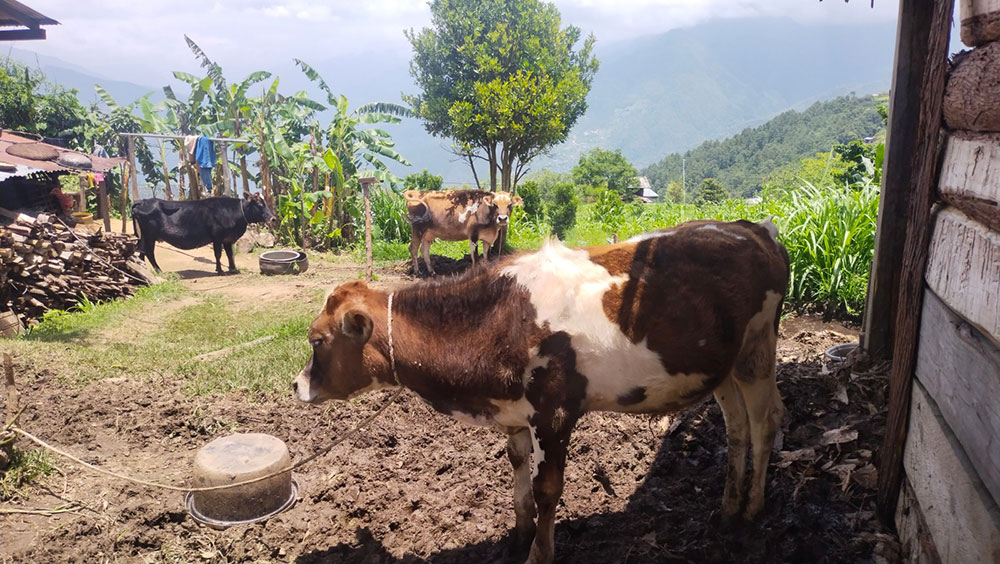… assured market attracts more dairy farmers
Neten Dorji
Trashigang— It is raining as Pema Lhamo, together with her helpers start their morning at 7am in a cattle shed, in Gongthung, Trashigang.
Pema ensures she finishes her morning task of, milking the four cows (Holstein Friesian) before the milk collection vehicle comes to collect her milk.
She contributes more than 30 litres everyday to the cooperative, which then sells it to Koufuku International Limited (KIL), Chenary. It has become a reliable source of income for the farmers like Pema who are involved in dairy farms.
Pema said the KIL and cooperative has helped farmers in the village become self-sufficient and has also contributed to the local economy.
“My average income is between Nu 20,000 and Nu 30,000 in a month. We save half and spend the rest on our children’s education,” she said.
She said many farmers in Gongthung have now become self-sufficient and have improved livelihoods that were once backward.
Although milk production was minimal, Tashi, a co-operative member, said that farmers in his village slowly became self-sufficient. They stopped going to work at the construction sites and were more occupied in rearing cattle.
“Today, most of the farmers have sent their children to school and constructed houses,” said Tashi. “This was all possible from the money they made from selling milk and its products.”
He said the group sells about 550-600 litres of milk every day to Koufuku International Limited for Nu 37, which then earns more than Nu 600,000 in a month.
Among the suppliers is 46-year-old Rinzin Wangmo from Wangka village who is earning Nu 20,000. But the earning from milk supply is just about enough to take care of her cow, said the mother of five. More than half the income goes into feed for the animals.
She said the majority of the people in Gongthung have started livestock farming with agriculture farming today.
“Easy market and the lucrative earning have lured people to take dairy farms despite challenges to buy feed,” she said. “I have three jersey cows.”
“Most dairy farmers are forced to cut back the animals’ feed as it has become costly,” said a dairy farmer. “Because of higher prices, we either have to cut the feed and risk lower production, or pay sky-high prices.”
Some farmers stopped giving commercial feed since they could not afford them.
Controlling the price of feeds and quality are two major issues that the group is facing currently. Many dairy farmers cry over the hike of Karma feeds and incur losses selling at lower prices.
“We would appreciate it if there is one feed company in the east so that our youth can operate many dairy farms and build their own futures,” said elderly farmer who has been a dairy farmer for a decade.
Farmers have collectively opened three dairy cooperatives in Yangneer gewog.
Yangneer gup, Duthob who is also DT chairperson said the new venture has helped reduce poverty in the gewog.
“With the support from the government and dzongkhag administration, the living standards have improved a lot,” he said. “Farmers were affected in the past without marketing, but now farmers are relieved as the Koufuku dairy plant is taking their milk.”
Meanwhile, with an assured market for fresh milk provided by the KIL, the group’s membership increased from 25 in 2009 to 33 in 2020. Dairy group membership currently stands at 68 after the 37 new members who joined the cooperative in 2021.
The quantity of milk produced also increased along with the increase in members from 130.8MT in the financial year 2020-2021 to 162.9 in financial year 2021-2022, showing a significant increase in milk production by 24.54%.
The Druk Chigthuen Namlay Deytshen was started in 2009 with 25 dairy farmers in Yangneer Gewog with financial support from Market Access & Growth Intensification Project (MAGIP-IFAD) and technical assistance from Trashigang dzongkhag livestock sector.


